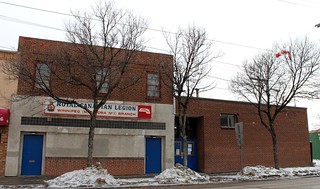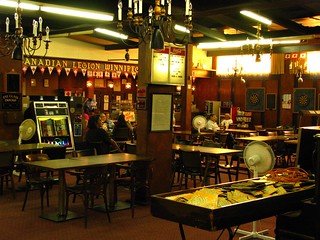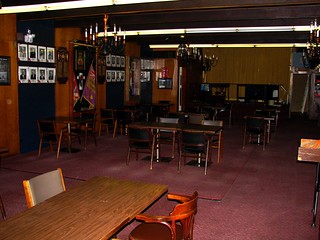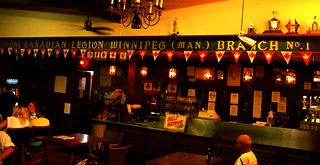Place: Former Royal Canadian Legion, Manitoba Branch No.1
Address: 522 - 526 Sargent Avenue
Opened: 1950
Architect: Unknown
Cost: Unknown
Address: 522 - 526 Sargent Avenue
Opened: 1950
Architect: Unknown
Cost: Unknown
The former Royal Canadian Legion, Manitoba Branch No. 1 is a combination of two buildings.
According to Henderson Directories, the south side of Sargent Avenue between Maryland to McGee had no buildings on it from the early 1920s to 1947. That year, the two-storey structure known as 622 Sargent was constructed and became home to Christeen's Beauty Salon and Perth's Cleaners.
The single-storey building at 626 Sargent first appears in the 1949 Henderson Directory as "Sargent Shopping Centre Shop". Either the project didn't get off the ground or the owner got a sweet offer to purchase because at the June 1949 meeting of Manitoba Branch No. 1's executive it was announced that they just bought it as their new headquarters.
I could find no "grand opening" articles in the Winnipeg Free Press, but the first event held at the Sargent Avenue hall appears to be women's auxiliary meeting on January 11, 1950.
The two-storey building continued to be a Perth's through the late 1960s. At some point, the year is unclear, the Legion purchased it and incorporated it into their existing hall.
The two-storey building continued to be a Perth's through the late 1960s. At some point, the year is unclear, the Legion purchased it and incorporated it into their existing hall.
Interior of the 1949 portion, (top), and 1950 portion, circa 2008
Manitoba Branch No. 1 was richly decorated in dark wood panelling, purple carpet and chandeliers. The lack of windows gave it a sombre feel, even on the sunniest of days. The one-storey portion had a mezzanine level that contained an office and washrooms. The basement of the building contained a second, more modern looking social hall.
Given its long history as the main Legion branch for the province, the walls were decorated with a variety of photographs, flags and other memorabilia. (To see some of it, check out my Flickr album of the building.)
November 4, 1950, Winnipeg Free Press
Boasting a membership of about 1,000 in its heyday, over the decades a number of factors caused this to dwindle to just over 100.
There was, of course, the national trend of declining Legion membership, despite changing the rules to allow those without prior military service to join. Even for Veterans of more recent conflicts the Legion hall didn't become a place to mingle.
The demographics of the neighbourhood around the branch also changed. In the 1950s and 60s tens of thousands of people relocated from older, established neighbourhoods near the city's core to the new suburbs that were springing up around the Greater Winnipeg area. The people replacing them were mainly new immigrants and First Nations, groups that didn't have the same attachment to a Canadian or Commonwealth Veterans' organization.
Throw in more recent issues of declining VLT revenues and allegations of financial impropriety of a couple of he branch's members and it became impossible to continue.
Source: Facebook
Still, this branch held on longer than many others. It closed on May 9, 2015 and the following month the building was put up for sale.
It was undergoing renovations to become the The Rift Valley Restaurant, Lounge and Banquet Hall when, on February 26, 2016, it caught fire. It is unclear whether the building can be salvaged.
Related
Canada's oldest legion Could Close Winnipeg Sun
Long History, Sad Ending Winnipeg Free Press
Streets Closed as Firefighters Fight Blaze CBC News
The "First Legion in Canada"
It was often noted by members of the branch that this was "The First Legion in Canada", established anywhere between 1915 to 1917 at this location, (just one example.) This is not exactly the case. Over time aspects of the building's history, the Legion's formation and the history of the Great War Veterans' Association got muddied together to create what is actually a very thin claim.
It has already been shown above that neither of these buildings date back as far as that.
Here's an overview of events leading up to their arrival at 626 Sargent Avenue in 1950.
The year cited for the branch's establishment, 1915 to 1917, predates the formation of the Royal Canadian Legion by about a decade. It is a reference to a previous organization called the Great War Veterans (GWVA).
It has already been shown above that neither of these buildings date back as far as that.
Here's an overview of events leading up to their arrival at 626 Sargent Avenue in 1950.
GWVA march June 4, 1919 (Source: MHS)
The year cited for the branch's establishment, 1915 to 1917, predates the formation of the Royal Canadian Legion by about a decade. It is a reference to a previous organization called the Great War Veterans (GWVA).
It was created in Winnipeg in 1917 as soldiers began returning from World War I and expressing concerns over their benefits, the high rate of inflation and, for many, the jobs they left behind had been taken my new immigrants willing to work for lower pay.
The GWVA played a key role in the lead up to the Winnipeg General Strike as they took to the streets in mass protests to demand changes. They added their might by voting in favour of striking. (For more on the role of returned soldiers in the strike.)
Though established in Winnipeg, the GWVA set up chapters in other provinces to become a national organization.
November 28, 1925, Winnipeg Free Press
The GWVA wasn't alone. There were dozens of organizations at the national, regional and local levels representing veterans. Realizing that they could better lobby governments and provide other services if they were under one banner, talks began in the early 1920s that culminated in the "National Unity Conference" held at Winnipeg's Marlborough Hotel on November 25 - 27, 1925.
Fifteen of the largest organizations attended and agreed to merge into the "Canadian Legion of the British Empire Service League", later renamed the Royal Canadian Legion. (You can read more here.)
It was then left to each province to set up their own commands.
March 18, 1926, Winnipeg Tribune
In Manitoba, that meant another meeting at the Marlborough Hotel on March 18, 1926 at which nine organizations: the Great War Veterans’ Association; Guards Association; Amputations’ Association; Tubercular Veterans’ Association; Naval Veterans’ Association; Fort Garry Horse Association; Nursing Sisters’ Association; Polish Association; 52nd Battalion Association and 44th Battalion Association, voted to merge into the Manitoba Command of the Canadian Legion.
Two organizations, the United Veterans' Association and Army and Navy Veterans' Association, which chose not to merge into the Legion at the national level, did not attend the Manitoba meeting.
November 11, 1941, Winnipeg Tribune
In July 1926 charters were issued to 33 Manitoba branches with the Winnipeg branch becoming "number one". They were located in the London Block on Main Street near McDermot, the home of what was the Great War Veterans' Association.
Over time, other Winnipeg branches were given charters and by 1930 there were twelve of them. Manitoba Branch No. 1, aside from a brief stint at 91 Albert Street, continued to operate from the London Block until 1949.
In the post-war period of 1945 to 1950 there was a huge growth in the ranks of the Legion and a number of branches opened new halls. This included the the Valour Road Legion on Burnell at Portage, the Swan River Branch, Neepawa Branch, Branch No. 68 at 220 McDermot and Fort Garry Branch No. 90 on St. Mary's Road. At least three new charters were granted for Oakville and Austin, Manitoba and Auden, Ontario.
Manitoba Branch No. 1 also found their new home on Sargent Avenue during this period.
As for the claim that this was the first Legion in Canada:
- Neither building dates back to the 19-teens.
- The building itself was not occupied by Manitoba Branch No. 1 until 1950.
- Manitoba Branch No. 1 got its charter on the same day as 33 other Manitoba Legions. (It's possible that other provinces gave out charters for their branches earlier than Manitoba did.)
- The GWVA was just one of 15 national groups that merged to form the Canadian Legion and one of nine local groups that merged to form the Manitoba chapter.
Given that Canadians have been fighting in wars and rebellions for more than a century prior to World War I, (for example, the War of 1812, North West Rebellions, the Boer War), it is hard to imagine that none of these organizations had roots that went back further than the GWVA's 1917. If that were the case, they could just as easily claim being "first".
- Terms like "oldest legion in Canada" or "Canada's first legion" etc. did not appear in newspaper descriptions in the formative years of the organization. If it was considered "first" in some manner or perhaps issued a symbolic first charter in the country as a gesture towards the work that the GWVA had done, you would think this claim would be noted since the branch's early days.
Instead, these terms do not appear in newspaper mentions until the 1970s, a half century after the formation of the Canadian Legion, when many of the generation involved in the 1925 negotiations and 1926 formation of the Manitoba command were gone.
I don't want to use the term urban myth. There probably was good reasoning at the time to use that reference. It's just that, over time, the claim has become so muddled as to how it is "first" that it is difficult to back up.
Manitoba Branch No. 1 also found their new home on Sargent Avenue during this period.
As for the claim that this was the first Legion in Canada:
- Neither building dates back to the 19-teens.
- The building itself was not occupied by Manitoba Branch No. 1 until 1950.
- Manitoba Branch No. 1 got its charter on the same day as 33 other Manitoba Legions. (It's possible that other provinces gave out charters for their branches earlier than Manitoba did.)
- The GWVA was just one of 15 national groups that merged to form the Canadian Legion and one of nine local groups that merged to form the Manitoba chapter.
Given that Canadians have been fighting in wars and rebellions for more than a century prior to World War I, (for example, the War of 1812, North West Rebellions, the Boer War), it is hard to imagine that none of these organizations had roots that went back further than the GWVA's 1917. If that were the case, they could just as easily claim being "first".
- Terms like "oldest legion in Canada" or "Canada's first legion" etc. did not appear in newspaper descriptions in the formative years of the organization. If it was considered "first" in some manner or perhaps issued a symbolic first charter in the country as a gesture towards the work that the GWVA had done, you would think this claim would be noted since the branch's early days.
Instead, these terms do not appear in newspaper mentions until the 1970s, a half century after the formation of the Canadian Legion, when many of the generation involved in the 1925 negotiations and 1926 formation of the Manitoba command were gone.
I don't want to use the term urban myth. There probably was good reasoning at the time to use that reference. It's just that, over time, the claim has become so muddled as to how it is "first" that it is difficult to back up.











My great-grandfather, A.E. (Jack) Moore), was Dominion Chairman of the Legion from its inception until the time of his death in 1950. I have a program from the dedication service of a Memorial Picture to him which was unveiled at the Winnipeg No. 1 Legion Branch. One of the speakers at the service was Duff Roblin, later Premier of Manitoba. I wonder whatever became of that Memorial Picture?
ReplyDelete